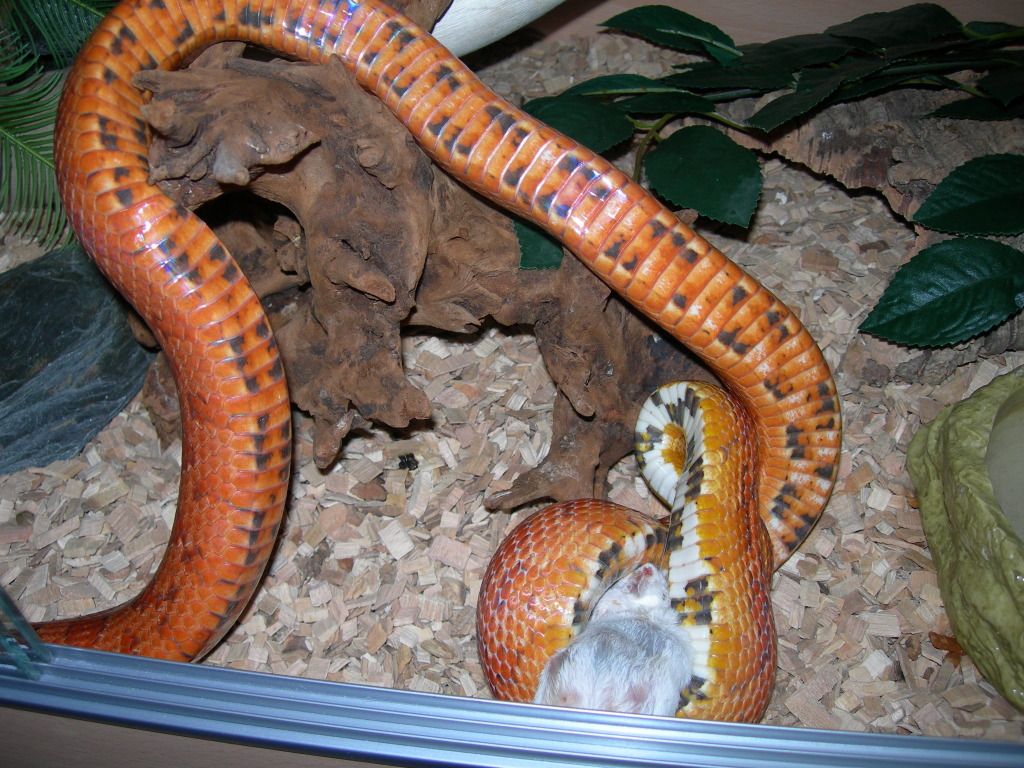| T O P I C R E V I E W |
| tk72 |
Posted - 09/12/2012 : 12:36:08
can you tell hets from belly scales? looking at Colas belly lately and it seems different from other normals. Here are a few belly shots.
Belly shots with brown in them.


near the tail gets more muddier brown.


thanks all. |
| 11 L A T E S T R E P L I E S (Newest First) |
| Isoldael |
Posted - 12/12/2012 : 18:46:18
I wish I had the funding/knowledge/time to research this. I absolutely love genetics. Either way, such "linked" genes have already been found for other species, though not to prove hets in particular. I'd very much love it if they existed for corns though :) |
| eeji |
Posted - 11/12/2012 : 23:36:23
There was talk of a study to map the full cornsnake genome but news of any progress (or even a start) has dried up. Something like that would answer an awful lot of questions :) |
| Isoldael |
Posted - 10/12/2012 : 22:05:27
-nods- Like in my example, there are genes that have a high prevalence with certain other genes (at least in other species), which is basically what het markers are to begin with. Like you said, if it was the gene itself producing a changed look, it would at the very least be co-dominant. So, IF there are any het markers for corns, it would be with related genes. The problem with these markers is that they are barely ever 100% accurate - some animals might display the trait that is a het marker without being het. So, at best, a het marker would give you an increased chance of the het and thus a better idea of what to breed your snake with :) |
| eeji |
Posted - 10/12/2012 : 21:45:30
if in your example its another gene that causes the belly chequer colour then it cannot be a marker for another gene unless they are somehow linked (that bit is beyond my knowledge).
A clear line through belly chequers used to be thought as a marker for diffused (which would make it codominant) but has since been identified and isolated into non diffused corns. This is now known as Masque which is a dominant trait which is why it was still appearing in het diffused animals. Because it has been separated from diffused, that is now a definite recessive with no markers. |
| Isoldael |
Posted - 10/12/2012 : 13:30:01
Eeji, it's not the gene itself that has to modify anything. If, say, the gene for amel would have a high prevalence in snakes that have another gene that causes orange belly checkers, that could make the orange belly checkers a het marker for amel even if the amel gene itself doesn't cause that. It wouldn't have to be co-dominant for that. That being said, I don't think much of that has been proven for corns, but it's definitely not impossible :) |
| Moppet |
Posted - 10/12/2012 : 00:02:31
Looks normal for a normal  My new normal female has quite a lot of belly checkers which have a little bit of black but some browny colours in them too, that's also quite normal I think. My new normal female has quite a lot of belly checkers which have a little bit of black but some browny colours in them too, that's also quite normal I think. |
| eeji |
Posted - 09/12/2012 : 17:42:03
theres no such thing as 'het markers' for recessive morphs. If a morph in het form alters the look of the snake in any way then it becomes codominant. |
| Isoldael |
Posted - 09/12/2012 : 14:50:10
My normal (jake) has this and he's het for amel. I've seen it in many, many normals though so I doubt it's an actual marker. |
| Dancross0 |
Posted - 09/12/2012 : 14:26:17
As above. As the snake gets older, there will more of the red bleeding onto the ventral.
Plisskens' belly.
 |
| Georgina |
Posted - 09/12/2012 : 12:49:02
That's normal for a normal lol both of mine had this x |
| tk72 |
Posted - 09/12/2012 : 12:37:01
Also if you want to see where she got stuck for an hour this morning, I am putting some pics on the pics section. Was not fun. |

